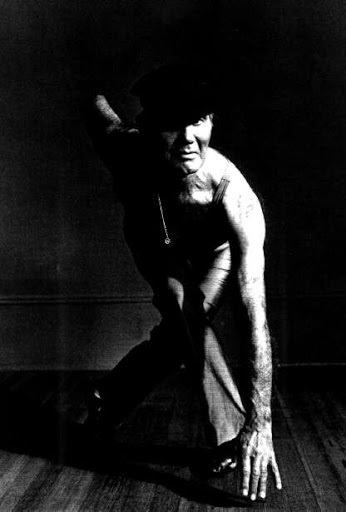Luigi
2008 Grand Marshal
2008 Grand Marshal

Luigi is sometimes referred to as "father jazz" since he is credited with creating the first formal jazz technique. There are numerous articles about Luigi and at least a couple of amateur films.
Since it's several decades "old" and is such a foundational technique, and since there aren't many
qualified teachers it's not as popular today. The strength of the technique is that it imparts the most solid fundamentals from which you can do anything.
Luigi (Louis Facciuto) was a young professional dancer when he moved to California to further his career. A serious car accident left one side of him paralyzed and with very bad eyesight (double vision). Doctors said he wouldn't recover, but in typical 'hollywood hero' fashion, he was determined to dance again. When he was well enough, he went back to the studio and began doing work at the bar. He got to where he could do ok, but when he tried to dance again on the floor, his disabilities robbed him of balance and coordination. Then it struck him: "If I can't dance without the bar, I'll take it with me!" He was able to keep himself upright and poised by pushing down on an imaginary bar! Thus, "pushing down to go up", pushing down with your arms on the space around you, lifting up from the crown of your head is an underlying paradigm of the Luigi technique (and so much dance in general). When you releve', you aren't simply using your calves, you are lifting up from your head and pushing down on the space, pushing on the "bar".
Perhaps the biggest component of the Luigi paradigm is "opposition". This where you are using one side of your body to control the "extension" of the opposite side. You "pull away left to reach right" for example. It harmonizes dance movement with natural body tendencies (e.g. walking: left foot front coincides with right arm front) and allowed Luigi to overcome his disabilities. This concept also places the body in optimum position for transitions and movement across the floor. And one must always keep moving. Luigi would stumble and fall if he tried to hold a position. So, internally, he was constantly reaching up with his head, pushing down, reaching out, clenching muscles.
Dance historians have defined Luigi’s style as classic jazz, elegant, sophisticated, and even liquid fire. Writers have labeled him, An Ambassador of Jazz, A Pioneer, The Teacher’s Teacher, A Body Doctor and mostly, The Innovator. The exercise routine he created for his own rehabilitation after a paralyzing accident became the world’s first complete technique for learning jazz dance. He got the professional nickname "Luigi" from Gene Kelly.Born Eugene Louis Faccuito in Steubenville, Ohio, Luigi grew up singing and dancing professionally throughout America’s heartland. After serving in WWII, he moved to Hollywood to pick up his young career. Soon tragedy struck in a near fatal car accident. Doctors held little hope he would recover from a basal skull fracture, deep coma and paralysis down one side of his body. Yet within that coma, an inner voice told him repeatedly, "Never stop moving, if you stop you’re dead." He eventually awoke to be told he would never walk again. His spirit said, "I’m going to dance."
By himself, Luigi started creating stretching exercises that helped him discover what had to be done to control the body. He learned to "put the body in the right position." To "feel from the inside out." After a long year of trail and error, he regained enough strength and equilibrium to start dance classes again at Falcon Studios in Hollywood.
Over a year later, Luigi, seen by a talent scout, was asked to audition for MGM’s "On the Town," starring Gene Kelly and Frank Sinatra. He got the job and started an 8 year chorus career in over 40 films, such as: "An American in Paris," "Annie Get Your Gun," "Singin’ in the Rain," "The Band Wagon," and "White Christmas." Choreographers Gene Kelly and Robert Alton became his mentors. They and others put him to work with: Fred Astaire, Cyd Charisse, Doris Day, Judy Garland, Bing Crosby, Mickey Rooney, Donald O’Connor, and Danny Kaye, among others.
During the long waiting periods on film sets, Luigi did his own exercises to make sure his body remained limber and would not ruin a "take." Soon dancers were following him, 10 or 20 at a time. Robert Alton told him
"You’ve got a great style you should teach it,"
So Luigi started teaching a "jazz class" in 1951. He liked to teach while working in film, live theater, and in TV variety shows such as: "The Colgate Comedy Hour," and "The Red Skelton Show." He never stopped moving.
For more information, please visit www.offjazz.com